#the cygnus loop
Explore tagged Tumblr posts
Text
What is the Cygnus Loop Nebula?
Post #8 on Physics and Astronomy, 29/10/23
Some 1,500 light years away, a star doomed to its end explodes. Its remnants race into space at whirlwind speeds. Now referred to as the Cygnus Loop nebula, scientists have been able to capture some beautiful images from the Hubble telescope, as well as understand its nature better.
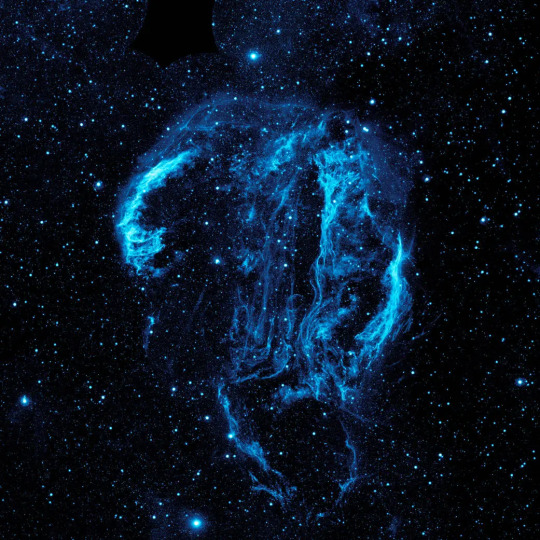
Discovered in 1784 by William Herschel, a star with mass over 20 times more than that of the Sun, exploded, ejecting its matter. The reason this is called the Cygnus nebula is because it was within the Cygnus constellation. What you see in the image above is the filaments of gas and dust visible as ultraviolet light. These were heated by the shockwave caused by the supernova, which, to this day, is still spreading outward from the original explosion.
Currently, the the shock is racing through space at a whopping 500,000 miles per hour (i.e. going to the moon and back in less than an hour). You may think that is a lot; however, relatively, this is quite slow, when you consider the average speed for a supernova shockwave (approximately 67,000,000 miles per hour).
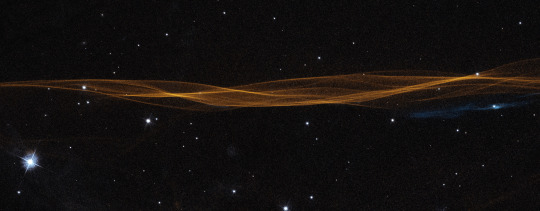
This photo shows a two-light-year-long section of glowing hydrogen filaments, which overall resembles a sheet if you viewed it from the side. They’re rippling, giving the appearance of twisted ribbons of light. This elegant shape arises as the shock waves encounters material of varying density.
The blue glow towards the back you see comes from the cooling of ionized oxygen atoms beginning to cool, emitting that glow.
Completely awe-inspiring, how today’s technology allows us to capture images like this in such crisp detail.
***
Sources:
Cygnus Loop image 1
Cygnus Loop image 2
#studyblr#physics#stem#sixth form#alevels#gcse#astronomy#astrophysics#engineering#the cygnus loop#nebula#pretty images#i can't stopstaring at the two photos#SO PRETTY#i love space#like omg
3 notes
·
View notes
Text

Cygnus Loop
3K notes
·
View notes
Photo
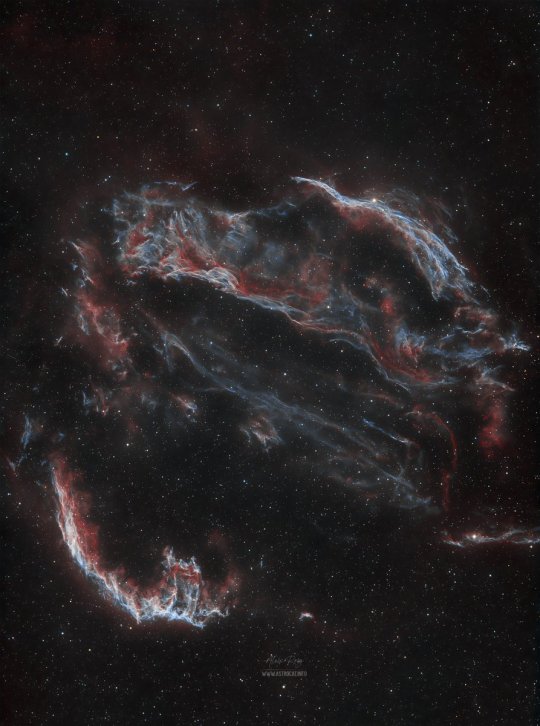
Cygnus Loop © Aleix Roig
#space#cygnus loop#astrophotography#universe#stars#nebula#night sky#solar system#astronomy#cosmos#galaxy#planet#nasa#planets
2K notes
·
View notes
Text
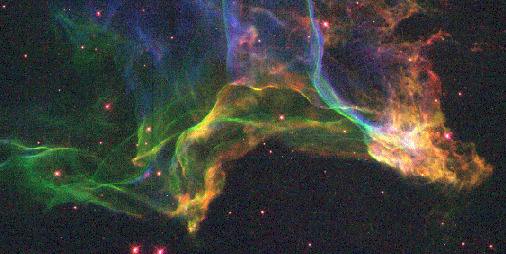
The Cygnus Loop - July 26th, 1996.
"15,000 years ago, a star in the constellation of Cygnus exploded - the shockwave from this supernova explosion is still expanding into interstellar space! The collision of this fast moving wall of gas with a stationary cloud has heated it, causing it to glow in visible as well as high energy radiation, producing the nebula known as the Cygnus Loop (NGC 6960/95). The nebula is located about 2500 light years away. The colours used here indicate emission from different kinds of atoms excited by the shock; oxygen-blue, sulfur-red, and hydrogen-green. This picture was taken with the Wide Field and Planetary Camera 2 onboard the Hubble Space Telescope."
126 notes
·
View notes
Text
The Western Veil Nebula
The Veil Nebula is interstellar debris from a very large star that violently exploded as a supernova about 15,000 years ago. This photo captures the leading shockwave as it continues to expand.
Astronomers call this Supernova Remnant the “Cygnus Loop”, because it is generally circular and viewed in the constellation of Cygnus the Swan. It is nearby at only 2,400 light years, and situated right in our own galactic spiral arm, making our image very crowded with nearby stars.
In this photo, we are looking at the outer edge of the Cygnus Loop debris field that appears facing towards the west. Note the colours: red is hydrogen, blue suggests oxygen, and sulfur is green.
A “Supernova” explosion occurs when an older star depletes fuel and begins to falter at generating a strong stellar wind. As the outward-push falters, gravity causes the aging star to catastrophically implode as a supernova. Indeed, the colours of blue and green suggest the presence of heavier elements, oxygen and sulphur, as formed in the core of older stars.

I photographed the Western Veil Nebula from my garden in Strasbourg France on a single night in August 2024. This is an ensemble of 80 photos, where each was a 3 minute exposure (4 hours of Astrophotography).
More information:
#astrophotography#astronomy#astrophotographie#astrophotographiefrance#astronomie#astronomiefrance#nebulae#veil nebula#veilnebula#Cygnus loop#nebula#strasbourg#cygnus#supernova remnant#supernova
54 notes
·
View notes
Text


me seeing cygnus returning in in your eyes vs watching the map and realizing that my perception of how he and leda met/their relationship and evolution was WAY OFF from what i had in my head and i will have to rework a lot of their dynamic in future fics and stuff
#also it contradicts already existing lore? but that’s a convo for another day#i do rlly like the map it just threw me for a loop#anyway HAPPY JD25 DAY WOOOO!!!!#just dance#just dance 2025#jd cygnus#jd night swan#jd leda#star says
32 notes
·
View notes
Photo

Pickering’s Triangle, part of the Veil Nebula // Alexandre EGON
#astronomy#astrophotography#nebula#emission nebula#supernova remnant#pickering's triangle#veil nebula#cygnus loop#cygnus
253 notes
·
View notes
Text

A quick and (very) dirty mosaic of the H alpha photos I had already taken for the three major components of the Cygnus loop.
I wanted to have an idea of what a future mosaic of this target could look like (probably won't be able to do better than that before the end of the year or next summer unfortunately)
Thought I could post it here while I finish processing newer photos.
23 notes
·
View notes
Text

Ic 1805 - The Heart Nebula
Photographer David Joyce - Space From My Backyard: Pictures I Took With A Telescope
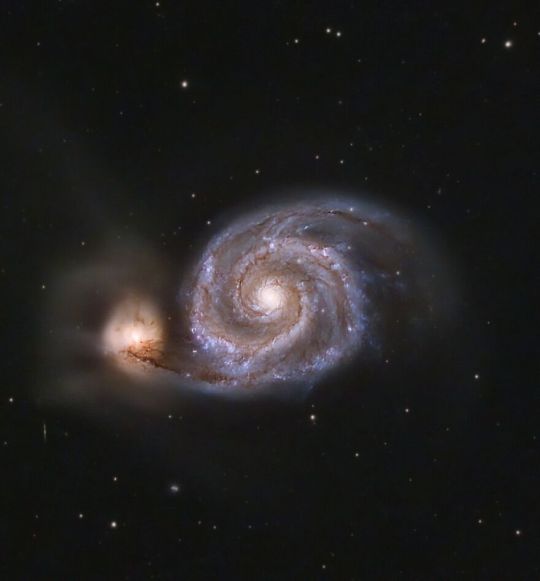
M51 - The Whirlpool Galaxy

The Cygnus Loop - A 4

M81 - Bode’s Galaxy
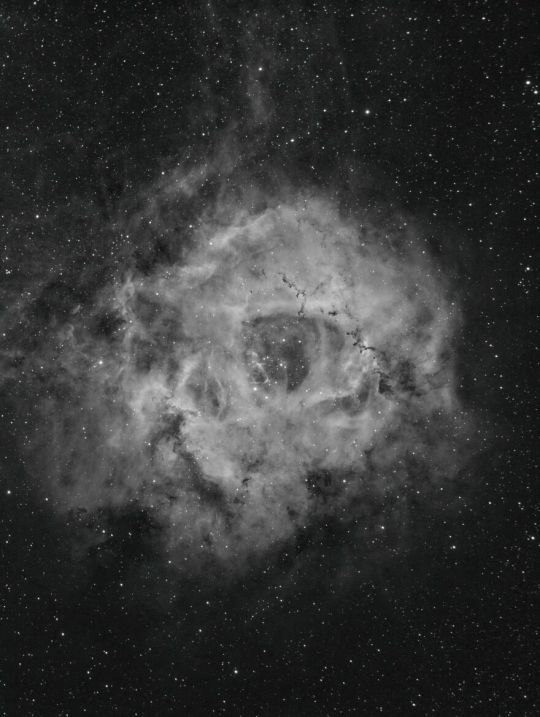
Ngc2244 - The Skull Nebula/Rosette Nebula
#david joyce#photographer#astronomy#space#heart nebula#telescope#nebula#whirlpool galaxy#galaxy#cygnus loop#bode's galaxy#skull nebula#rosette nebula#nature
78 notes
·
View notes
Text

This is an image of a small portion of the Cygnus Loop supernova remnant, taken with the Wide Field and Planetary Camera on NASA's Hubble Space Telescope on April 24, 1991. This research is being presented at the 181st Meeting of the American Astronomical Society in Phoenix, AZ on January 6, 1993, by Dr. Jeff J. Hester, of Arizona State University. The Cygnus Loop marks the edge of a bubble-like, expanding blast wave from a colossal stellar explosion which occurred about 15,000 years ago. The HST image shows the structure behind the shock waves in the Cygnus Loop with unprecedented clarity. This is allowing astronomers, for the first time, to compare directly the actual structure of the shock with theoretical model calculations. Besides supernova remnants, these shock models are important in understanding a wide range of astrophysical phenomena, ranging from winds in newly-formed stars to cataclysmic stellar outbursts. The supernova blast wave is slamming into tenuous clouds of interstellar gas. This collision heats and compresses the gas, causing it to glow. The shock acts as a searchlight by revealing the structure of the interstellar medium. Hubble's detailed image shows the blast wave overrunning dense clumps of gas. Though HST can reveal details about as small as our Solar System, the clumps are still unresolvable. This means that they must be small enough to fit inside our Solar System, making them relatively small structures by interstellar standards. A bluish ribbon of light stretching left to right across the picture might be a knot of gas ejected by the supernoya. This interstellar "bullet," traveling over three million miles per hour (5 million km), is just catching up with the shock front (which has been slowed by plowing into interstellar material). The Cygnus Loop appears as a faint ring of glowing gases about three degrees across (six times the diameter of the Full Moon), located in the northern constellation Cygnus the Swan. The supernova remnant is within the plane of our Milky Way Galaxy and is 2,600 light-years away. Supernova remnants play an important role in stellar evolution by enriching space with heavy elements, and triggering new star formation by compressing interstellar gas. Technical Details: The photo is a combination of separate images taken in three colors. Oxygen atoms (blue) emit light at temperatures of 30,000 to 60,000 degrees Celsius (50,000 to 100,000 degrees Fahrenheit). Hydrogen atoms (green) arise throughout the region of shocked gas. Sulfur atoms (red) form when the gas cools to around 10,000 degrees Celsius (18,000 degrees Fahrenheit).
Source: The Cygnus Loop Supernova Remnant
15 notes
·
View notes
Text
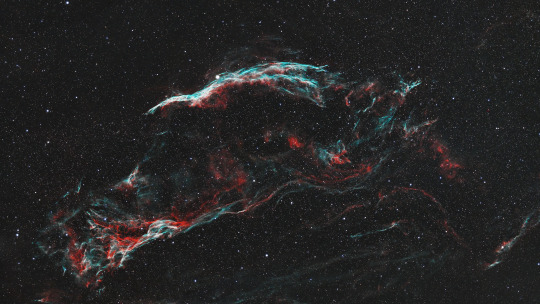
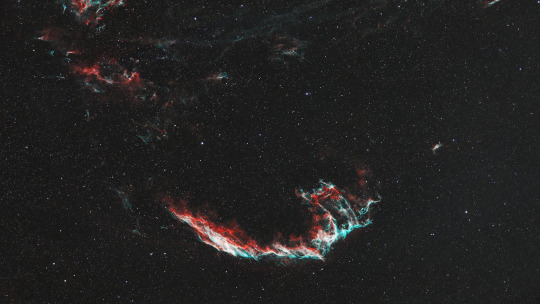

Finished 2 panel mosaic of the Cygnus Loop Supernova Remnant (SH 2-103) Data in H-alpha with RGB (reduced) stars)
#my photography#astrophotography#space photography#veil nebula#eastern veil nebula#western veil nebula#cygnus loop#SH 2-103#NGC 6960#NGC 6992#H-alpha data
12 notes
·
View notes
Text
Seeing the Cygnus Loop in a New Way
The Cygnus Loop, also known as the Veil Nebula, is a supernova remnant – the remains of the explosive death of a massive star. Studying images like these leads to discovery, but NASA’s Chandra X-ray Observatory provides another way to experience this data: three-dimensional (3D) models that allow people to explore – and print – […] from NASA https://ift.tt/5Dz39xV
0 notes
Text

Rampaging Fronts of the Veil Nebula - March 7th, 1996.
"A supernova explosion of a high-mass star results in fast moving blast waves. At the front of the waves shown above, ionised gas in the Veil Supernova Remnant rushes out from the explosion, sweeps up material, and breaks up many atoms into constituent ions and electrons. Observations with the Hubble Space Telescope in 1993 indicate that the blue shock wave was catapulted away from the stellar explosion after the red shock wave, and had yet to catch up to it in some regions. The Veil supernova remnant's has a very large angular size - six times the diameter of the full Moon - and different parts of it are known as the "Cygnus Loop" and catalog numbers NGC 6960, NGC 6979, NGC 6992, and NGC 6995."
#nasa#space#cosmos#universe#astronomy#astrophysics#astrophotography#veil nebula#supernova remnant#cygnus loop
117 notes
·
View notes
Photo

The Cygnus Loop
Credits: ASU, NASA
99 notes
·
View notes
Photo
Picture with Annotations:
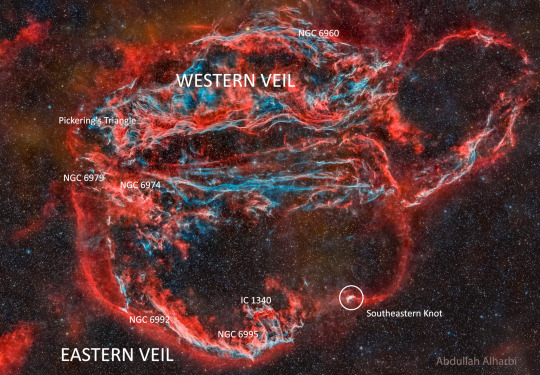

2025 June 2
Veil Nebula: Wisps of an Ancient Supernova Image Credit & Copyright: Abdullah Alharbi
Explanation: Wisps like this are all that remain visible of a Milky Way star. About 7,000 years ago that star exploded in a supernova, leaving the Veil Nebula. At the time, the expanding cloud was likely as bright as a crescent Moon, remaining visible for weeks to people living at the dawn of recorded history. Today, the resulting supernova remnant, also known as the Cygnus Loop, has faded and is now visible only through a small telescope directed toward the constellation of the Swan (Cygnus). The remaining Veil Nebula is physically huge, however, and even though it lies about 1,400 light-years distant, it covers over five times the size of the full Moon. The featured picture was taken in Kuwait in mid-2024 and features light emitted by hydrogen in red and oxygen in blue. In deep images of the complete Veil Nebula like this, even studious readers might not be able to identify the iconic filaments.
∞ Source: apod.nasa.gov/apod/ap250602.html
#astronomy#astronomy picture of the day#supernova remnant#Veil Nebula#Cygnus Loop#Western Veil#Witch's Broom Nebula#Caldwell 34#NGC 6960#Eastern Veil#Caldwell 33#NGC 6992#NGC 6995#Bat Nebula#IC 1340#Pickering's Triangle#Fleming's Triangular Wisp#NGC 6974#NGC 6979#Southwestern Knot
78 notes
·
View notes
Text
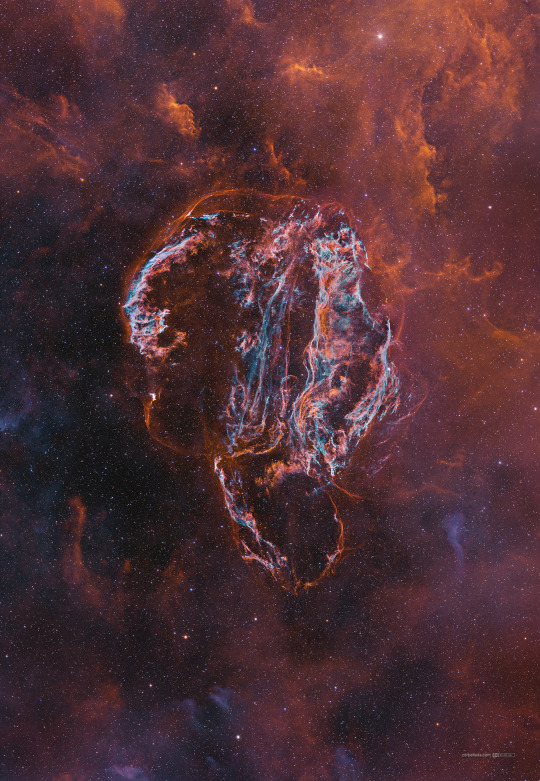
The Cygnus Loop, Sh2-103 // Jose Carballada
#astronomy#astrophotography#nebula#emission nebula#supernova remnant#cygnus loop#veil nebula#western veil nebula#eastern veil nebula#pickering's triangle#Sh2-103#NGC 6960#NGC 6992#NGC 6995#IC 1340#NGC 6974#NGC 6979#cygnus
106 notes
·
View notes